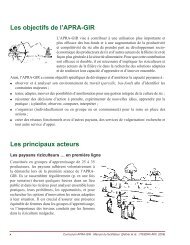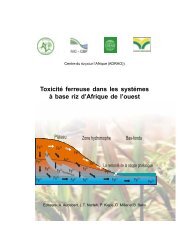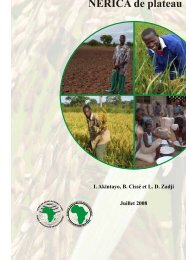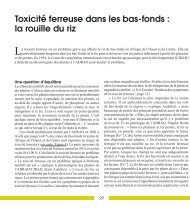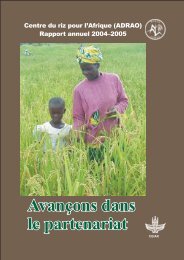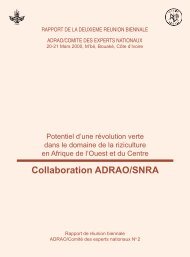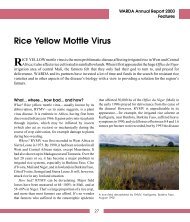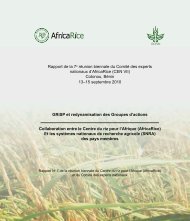Theme 5: Integrated management of pests, diseases and weeds in rice-based systemsTraoré et al.: RYMV diversity and genetic c<strong>on</strong>trol of RYMVleaves in phosphate buffer 0.1M pH 7.2 (with 10 ml of buffer per 1 g of leaves). Carborundum 600-grid wasadded to <strong>the</strong> extract, which was <strong>the</strong>n used to rub <strong>the</strong> leaves of young rice plants (aged 14 days). Appearance ofsymptoms was m<strong>on</strong>itored every week for 6 m<strong>on</strong>ths.Determining VPg sequences and directed mutagenesisThe viral protein genome-linked was amplified by reverse transcripti<strong>on</strong> polymerase chain reacti<strong>on</strong> (RT-PCR) asdescribed by Pinel-Galzi et al. (2007). Nucleotide sequences were <strong>the</strong>n determined by direct sequencing ofamplificati<strong>on</strong> products. Sequence collecti<strong>on</strong> and analysis were carried out using bioinformatics softwarepackage Lasergene DNAStar. Mutati<strong>on</strong>s associated with resistance avoidance were identified. To validate <strong>the</strong>role of each of <strong>the</strong>se mutati<strong>on</strong>s in <strong>the</strong> <str<strong>on</strong>g>virus</str<strong>on</strong>g> pathogenicity, corresp<strong>on</strong>ding changes were introduced in aninfectious cl<strong>on</strong>e through direct mutagenesis (Hébrard et al., 2008; Brugidou et al., 1995). The infectious cl<strong>on</strong>ethus modified was <strong>the</strong>n inoculated to rice plants and symptoms m<strong>on</strong>itored as previously.Results and discussi<strong>on</strong>Mutati<strong>on</strong>s associated with rymv1-2 allele avoidanceIn total, 10 isolates out of 114 were able to avoid <strong>the</strong> resistance in <strong>the</strong> highly resistant rice variety Gigante. TheVPg sequences (41 sequences) were determined in <strong>the</strong> plants that presented symptoms and were compared withthose of <strong>the</strong> original isolates. Five n<strong>on</strong>syn<strong>on</strong>ym mutati<strong>on</strong>s were located in a short regi<strong>on</strong> of 15 amino acids (aa)out of <strong>the</strong> 79 aa that make <strong>the</strong> VPg (Table 1). The implicati<strong>on</strong> of <strong>the</strong>se mutati<strong>on</strong>s in avoiding <strong>the</strong> resistant allelerymv1-2 was dem<strong>on</strong>strated by directed mutagenesis (Pinel-Galzi et al., 2007). Candidate mutati<strong>on</strong>s wereseparately introduced in an infectious cl<strong>on</strong>e of RYMV which could not avoid resistance (Brugidou et al., 1995).All candidate mutati<strong>on</strong>s introduced in <strong>the</strong> infectious cl<strong>on</strong>e allowed <strong>the</strong> avoidance of allele rymv1-2 in Gigante orBekarosaka.The most frequent mutati<strong>on</strong> was that of positi<strong>on</strong> 48. At this positi<strong>on</strong>, <strong>the</strong> arginine residue (R) was replacedby six o<strong>the</strong>r possible amino acids: tryptophan (W), glycine (G), glutamic acid (E), valine (V) or thre<strong>on</strong>ine (T).M<strong>on</strong>itoring <strong>the</strong> appearance of <strong>the</strong>se mutati<strong>on</strong>s over time has shown a major scenario bringing into play R, G andE residues. In a first phase, <strong>the</strong> R residue of <strong>the</strong> avirulent isolate was replaced by <strong>the</strong> G residue (making <strong>the</strong>isolate virulent). In a sec<strong>on</strong>d phase, <strong>the</strong> G residue was replaced by an E residue that, when fixed, was neverreplaced. Thus, <strong>the</strong> E residue appeared as more adapted to rymv1-2 allele avoidance.Table 1. Mutati<strong>on</strong>s of <strong>the</strong> viral protein genome-linked (VPg) involved in rymv1-2 allele avoidanceRYMV isolate Strain Sequences afterAmino acid positi<strong>on</strong>s in <strong>the</strong> VPg†avoidance38 42 43 48 52C<strong>on</strong>trol S1 1 R N T R HMli 203 S2 1 . . . W .Mli202 Sa 1 Y . . G .Mli 206 Sa 1 . . . G .Mli 145 Sa 1 . . . . YCI4 S1 1 Q . . E .CI4 S1 2 . . . GCI4 S1 3 . . . ICI4 S1 4 . . . VBF5 S1 1 . . . YMg16 S4 1 . Y A E YMg16 S4 2 . . . GMg16 S4 3 . . . TTz225 S4 1 . . . E .Tz230 S4 1 . . . G .Tz209 S6 1 . . . E .† The dots indicate <strong>the</strong> presence of <strong>the</strong> same amino acids as <strong>the</strong> c<strong>on</strong>trol isolate not able to avoid <strong>the</strong> resistance allele rymv1-2.Mutati<strong>on</strong>s associated with rymv1-3 allele avoidanceIn <strong>the</strong> case of allele rymv1-3, sequences of avoidance isolates were obtained by inoculating variety Tog5681.Analyzing mutati<strong>on</strong>s that occurred allowed identificati<strong>on</strong> of two n<strong>on</strong>syn<strong>on</strong>ym mutati<strong>on</strong> positi<strong>on</strong>s involved inresistance avoidance. These were positi<strong>on</strong>s 41 and 52. In positi<strong>on</strong> 41, <strong>the</strong> serine residue (S) present in <strong>the</strong>avirulent isolate was replaced by an alanine residue (A) or by a proline residue (P). In positi<strong>on</strong> 52, <strong>the</strong> histidineresidue (H) was replaced by a tyrosine residue (Y). The individual introducti<strong>on</strong> of mutati<strong>on</strong>s 41A and 41P in <strong>the</strong>infectious cl<strong>on</strong>e or <strong>the</strong>ir respective combinati<strong>on</strong> with mutati<strong>on</strong> 52Y allowed us to reproduce <strong>the</strong> symptoms ofRYMV in Tog5681. This c<strong>on</strong>firmed that all three mutati<strong>on</strong>s were resp<strong>on</strong>sible for <strong>the</strong> capacity of RYMV isolates5.3.2 Sec<strong>on</strong>d Africa <str<strong>on</strong>g>Rice</str<strong>on</strong>g> C<strong>on</strong>gress, Bamako, Mali, 22–26 March 2010: Innovati<strong>on</strong> and Partnerships to Realize Africa’s <str<strong>on</strong>g>Rice</str<strong>on</strong>g> Potential
Theme 5: Integrated management of pests, diseases and weeds in rice-based systemsTraoré et al.: RYMV diversity and genetic c<strong>on</strong>trol of RYMVto avoid <strong>the</strong> resistance allele rymv1-3. Positi<strong>on</strong> 52 appeared to be very important in <strong>the</strong> resistance avoidance,since mutati<strong>on</strong> 52Y was associated with avoidance of allele rymv1-2 as well as to that of allele rymv1-3.Role of <strong>the</strong> polymorphism E/T in positi<strong>on</strong> 49 of <strong>the</strong> VPgThe capacity of RYMV isolates to undergo mutati<strong>on</strong>s leading to avoidance of alleles rymv1-2 and rymv1-3 hasbeen found to be closely associated with polymorphism in positi<strong>on</strong> 49 of <strong>the</strong> protein sequence of VPg. In allRYMV isolates, two amino acids can be observed in this positi<strong>on</strong>. This is a glutamic acid residue (E) or athre<strong>on</strong>ine residue (T). Isolates capable of avoiding rymv1-2 had <strong>the</strong> entire residue 49E. N<strong>on</strong>e of <strong>the</strong>se isolateswere able to infect Tog5681, showing <strong>the</strong> inability to avoid rymv1-3 when isolates have residue E in positi<strong>on</strong> 49of <strong>the</strong> VPg. Avoidance of rymv1-3 was achieved exclusively by isolates having residue 49T. A few isolates withresidue 49T capable of avoiding rymv1-3 were capable of avoiding rymv1-2, although <strong>the</strong> majority were notable to do so. Cod<strong>on</strong> 49 of <strong>the</strong> VPg is under possible high selecti<strong>on</strong>, a situati<strong>on</strong> that shows that mutati<strong>on</strong>soccurring at <strong>the</strong> level of this cod<strong>on</strong> give a selective advantage to RYMV isolates. Pathogenicity c<strong>on</strong>trastobserved in isolates with residue 49E and those with residue 49T shows an adaptati<strong>on</strong> of <strong>the</strong> 49E isolates to <strong>the</strong>genetic pool O. sativa. C<strong>on</strong>versely, isolates with residue 49T are adapted to genetic pool O. glaberrima. Thisadaptati<strong>on</strong> to genetic pool modulates <strong>the</strong> propensity of RYMV to develop virulence capacities allowing <strong>the</strong>m toavoid resistances.RYMV adaptati<strong>on</strong> to <strong>the</strong> gene pool O. sativa or to that of O. glaberrima indicates that <strong>the</strong> sustainability of<strong>the</strong> resistance to <strong>the</strong> <str<strong>on</strong>g>virus</str<strong>on</strong>g> depends closely to <strong>the</strong> resistance allele deployed and to <strong>the</strong> <str<strong>on</strong>g>virus</str<strong>on</strong>g> populati<strong>on</strong>s. Thus,<strong>the</strong> deployment of allele rymv1-3 (gene pool O. glaberrima) in regi<strong>on</strong>s where <strong>the</strong> <str<strong>on</strong>g>virus</str<strong>on</strong>g> populati<strong>on</strong>s compriseisolates with residue 49E would result to resistance sustainability. C<strong>on</strong>versely, <strong>the</strong> deployment of allele rymv1-2(gene pool O. sativa) in a regi<strong>on</strong> dominated by <str<strong>on</strong>g>virus</str<strong>on</strong>g> isolates with residue 49E would favor <strong>the</strong> emergence ofvirulent variants and <strong>the</strong> n<strong>on</strong>sustainability of <strong>the</strong> resistance.ReferencesAbo ME, Sy AA and Alegbejo MD. 1998. <str<strong>on</strong>g>Rice</str<strong>on</strong>g> <str<strong>on</strong>g>yellow</str<strong>on</strong>g> <str<strong>on</strong>g>mottle</str<strong>on</strong>g> <str<strong>on</strong>g>virus</str<strong>on</strong>g> (RYMV) in Africa: Evoluti<strong>on</strong>, distributi<strong>on</strong>,ec<strong>on</strong>omic significance and sustainable rice producti<strong>on</strong> and management strategies. Journal of SustainableAgriculture 11: 85–111.Albar L, Bangratz-Reyser M, Hebrard E, Ndji<strong>on</strong>djop MN, J<strong>on</strong>es M and Ghesquière A. 2006. Mutati<strong>on</strong>s in <strong>the</strong>eIF(iso)4G translati<strong>on</strong> initiati<strong>on</strong> factor c<strong>on</strong>fer high resistance of rice to <str<strong>on</strong>g>Rice</str<strong>on</strong>g> <str<strong>on</strong>g>yellow</str<strong>on</strong>g> <str<strong>on</strong>g>mottle</str<strong>on</strong>g> <str<strong>on</strong>g>virus</str<strong>on</strong>g>. PlantJournal 47: 417–426.Bakker W. 1970. <str<strong>on</strong>g>Rice</str<strong>on</strong>g> <str<strong>on</strong>g>yellow</str<strong>on</strong>g> <str<strong>on</strong>g>mottle</str<strong>on</strong>g>, a mechanically transmissible <str<strong>on</strong>g>virus</str<strong>on</strong>g> disease of rice in Kenya. Ne<strong>the</strong>rlandsJournal of Plant Pathology 76: 53–63.Brugidou C, Holt C, Yassi MN, Zhang S, Beachy R and Fauquet C. 1995. Syn<strong>the</strong>sis of an infectious full-lengthcDNA cl<strong>on</strong>e of <str<strong>on</strong>g>Rice</str<strong>on</strong>g> <str<strong>on</strong>g>yellow</str<strong>on</strong>g> <str<strong>on</strong>g>mottle</str<strong>on</strong>g> <str<strong>on</strong>g>virus</str<strong>on</strong>g> and mutagenesis of <strong>the</strong> coat protein. Virology 206: 108–115.Fargette D, Pinel A, Traoré O, Ghesquière A and K<strong>on</strong>até G. 2002. Emergence of resistance-breaking isolates of<str<strong>on</strong>g>Rice</str<strong>on</strong>g> <str<strong>on</strong>g>yellow</str<strong>on</strong>g> <str<strong>on</strong>g>mottle</str<strong>on</strong>g> <str<strong>on</strong>g>virus</str<strong>on</strong>g> during serial inoculati<strong>on</strong>s. European Journal of Plant Pathology 108: 585–591.Hébrard E, Pinel-Galzi A and Fargette D. 2008. Virulence domain of <strong>the</strong> RYMV genome-linked viral proteinVPg towards rice rymv1-2-mediated resistance. Archives of Virology 153: 1161–1164.Ioanidou D, Lett J, Pinel A, Assigbetsé K, Brugidou C, Ghesquière A, Nicole M and Fargette D. 2000.Resp<strong>on</strong>ses of Oryza sativa jap<strong>on</strong>ica subspecies to infecti<strong>on</strong> with <str<strong>on</strong>g>Rice</str<strong>on</strong>g> <str<strong>on</strong>g>yellow</str<strong>on</strong>g> <str<strong>on</strong>g>mottle</str<strong>on</strong>g> <str<strong>on</strong>g>virus</str<strong>on</strong>g>. Physiologicaland Molecular Plant Pathology 57: 177–188.K<strong>on</strong>até G, Traoré O and Coulibaly MM. 1997. Characterizati<strong>on</strong> of <str<strong>on</strong>g>Rice</str<strong>on</strong>g> <str<strong>on</strong>g>yellow</str<strong>on</strong>g> <str<strong>on</strong>g>mottle</str<strong>on</strong>g> <str<strong>on</strong>g>virus</str<strong>on</strong>g> isolates in Sudano-Sahelian areas. Archives of Virology 142: 1117–1124.Kouassi NK, N’Guessan P, Albar L, Fauquet C and Ghesquière A. 2005. Distributi<strong>on</strong> and characterizati<strong>on</strong> of<str<strong>on</strong>g>Rice</str<strong>on</strong>g> <str<strong>on</strong>g>yellow</str<strong>on</strong>g> <str<strong>on</strong>g>mottle</str<strong>on</strong>g> <str<strong>on</strong>g>virus</str<strong>on</strong>g>: A threat to African farmers. Plant Disease 89: 124–132.Ndji<strong>on</strong>djop MN, Albar L, Fargette D, Fauquet C and Ghesquière A. 1999. The genetic basis of high resistanceto <str<strong>on</strong>g>Rice</str<strong>on</strong>g> <str<strong>on</strong>g>yellow</str<strong>on</strong>g> <str<strong>on</strong>g>mottle</str<strong>on</strong>g> <str<strong>on</strong>g>virus</str<strong>on</strong>g> (RYMV) in cultivars of two cultivated rice species. Plant Disease 83: 931–935.Pinel-Galzi A, Rakotomalala M, Sangu E, Sorho F, Kanyeka Z, Traoré O, Sérémé D, Poulicard N,Rabenantoandro Y, Séré Y, K<strong>on</strong>até G, Ghesquière A, Hébrard E and Fargette D. 2007. Theme andvariati<strong>on</strong>s in <strong>the</strong> evoluti<strong>on</strong>ary pathways to virulence of an RNA plant <str<strong>on</strong>g>virus</str<strong>on</strong>g> species. PLoS Pathogens 3:e180.Rakotomalala M, Pinel-Galzy A, Albar L, Ghesquière A, Rabenantoandro Y, Ramavovolol<strong>on</strong>a P and FargetteD. 2008. Resistance to <str<strong>on</strong>g>Rice</str<strong>on</strong>g> <str<strong>on</strong>g>yellow</str<strong>on</strong>g> <str<strong>on</strong>g>mottle</str<strong>on</strong>g> <str<strong>on</strong>g>virus</str<strong>on</strong>g> in rice germplasm in Madagascar. European Journal ofPlant Pathology 122: 277–286.Traoré O, Sorho F, Pinel A, Abubakar Z, Banwo O, Maley J, Hébrard E, Winter S, Séré Y, K<strong>on</strong>até G andFargette D. 2005. Processes of <str<strong>on</strong>g>diversificati<strong>on</strong></str<strong>on</strong>g> and dispersi<strong>on</strong> of <str<strong>on</strong>g>Rice</str<strong>on</strong>g> <str<strong>on</strong>g>yellow</str<strong>on</strong>g> <str<strong>on</strong>g>mottle</str<strong>on</strong>g> <str<strong>on</strong>g>virus</str<strong>on</strong>g> inferred fromlarge-scale and high-resoluti<strong>on</strong> phylogeographical studies. Molecular Ecology 14: 2097–2110.Sec<strong>on</strong>d Africa <str<strong>on</strong>g>Rice</str<strong>on</strong>g> C<strong>on</strong>gress, Bamako, Mali, 22–26 March 2010: Innovati<strong>on</strong> and Partnerships to Realize Africa’s <str<strong>on</strong>g>Rice</str<strong>on</strong>g> Potential 5.3.3



